By: Ashley Rivas
I was a judge for the Seattle Indies this past July, and I got to experience a lot of games. Some really stuck in my head, for better or for worse (play a video game that totally rattles your perception of perspective and you’ll see what I mean). I freaking loved getting to play the games, but when the actual Seattle Indies Expo rolled around, I got to actually meet the devs. I was so smitten by one game in particular that I made a beeline to it at the Expo, and made sure it was the first one I played. And whaddya know, it’s a game that features cats, so anyone reading this on the Internet is going to love it too.
Meow Wars is the first game from Seattle-based indie dev Adrian Sotomayor, who founded Taco Truck Games in 2016. The game features militarized cats engaging in combat with a traditional deck of cards, similar to the concept of the card game War. I’ll review the game itself later, but let me just say this: I expected to play the demo for a minute and get bored. I played the demo in its entirety multiple times at home and played the entire demo again at the Expo. And I will play it like an addict when it officially releases.
I got a chance to sit down and talk to Adrian about Meow Wars, the indie dev scene in Seattle, and how it compares to those AAA studios he used to work for. We were in the Indies Workshop where he sets up base camp daily, and got to talk a bit about how awesome that situation is too!
Warning: Lots of discussion of the Seattle indie game developer scene ahead.
The question
I envision this project to look at indie gaming development as a whole, rather than just Taco Truck Games specifically. We’re starting this interview and review party with Adrian simply because he’s awesomely open and helpful to anyone looking to break into game development.
Which seems like a useful place to start: what was the process of creating your own indie game studio actually like? And what are good things for people to think about when they get started?
Adrian Sotomayor: The man with the plan behind Meow Wars
Ash: Why militarized cats? Where did that concept even begin to come from?
Adrian: Honestly, it started as a version of War [the card game]. I needed some kind of theme, so I went to an indie draw coffee event a few blocks away. I just started drawing, and I drew military cats. It was really just people drawing whatever, so I played around with it. It was kind of a brainstorming session.
Ash: Are the people there mostly artists?
Adrian: A lot of indie devs, actually, and people who just want to draw. I got the idea there, and started fleshing it out from there. I came up with the names, like Major Mittens and Lieutenant Luna. Then I reached out to artists over Instagram, and found Sam Moore from New Zealand. I liked his style, and originally intended for him to just do portraits from the soldiers up. After he delivered the initial pieces, I realized it was way better than I originally planned, so the style shifted from there. I embraced his style, and redid the logo, the UI, everything.
Ash: When I played it that the art was a huge sell. It’s so different!
Adrian: It’s all hand drawn on paper using Copic markers, actually.
Ash: I’m a Copic addict and fully support that. Was it tricky to use a traditional format?
Adrian: He scans it in high resolution, and then I animate it. Animation was actually an afterthought. The Galvanic team is in the Workshop, and their artists showed off Spine one month. So I tried an animation test with Lieutenant Luna, and had to cut her up and fill in behind to make her riggable. My first mesh to formation was just learning along the way.
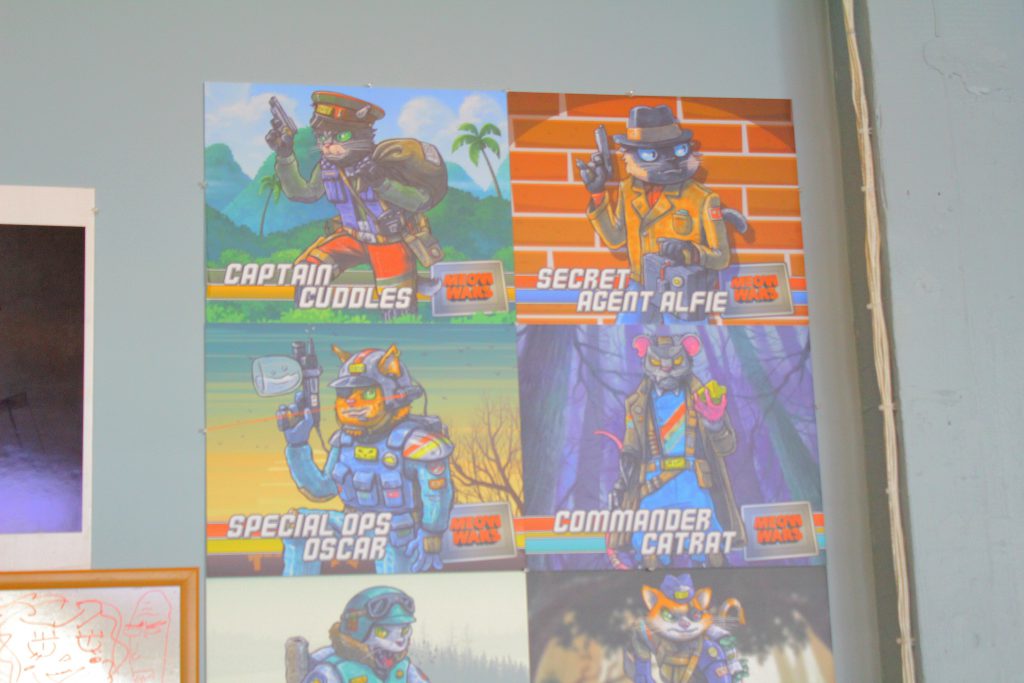
Fancy feast your eyes on these beauts.
Ash: I tried something similar with animating a chopped character and hated it; it pushed me back towards fixed sprites. Did you have that moment where you thought this might not be worth it, or did you know that it was too good to not use?
Adrian: I spent a day and a half rigging the first character, and it was taking longer than I thought. But once I had the first animation, I saw that it had potential, and really brought the characters to life. I didn’t really have the “this is a mistake” moment until I was four characters in and realized I had to do it for every character. There’s a character in my inbox that isn’t even included yet because it’s so much work. But once I did that first test, I saw how much better it made the game, and the cats just came alive.
Ash: So with something you’re not super-experienced with, as a team of one, how often do you consider asking for help or hiring someone as opposed to learning it on your own?
Adrian: My goal for my first game was to do a whole game from start to finish, and try it first myself to see how hard it is or how long it will take. A good example is the art. I had the intention of doing it all myself, and I used to draw a lot, but I haven’t drawn in years. I reached that moment where I realized I could contract out to have someone do it much better than I can. For the spine animations, I’ve considered hiring a real animator, but I put some more time into it and realized I could learn it. Maybe for a future project I wouldn’t do it all myself, but now I know what the work would be, and what the scope is.
Ash: You just did the Seattle Indies Expo, and Geek Girl Con. How were those?
Adrian: They were great! SIX was amazing, it’s one of the best events you can go to as an indie if you live in Seattle. The price is totally worth it; PAX is over $1000, but SIX is cost effective. You’re part of the support group, and it’s still on PAX weekend, so you’ll still get that crowd. I’ll definitely do that again. Geek Girl Con is a little different; it’s not a gaming convention, it’s a more general geek convention. There were a lot of families that would bring their three or four kids and have them at my stations, and I’d talk to the parents. It was a different audience. They’re more casual gamers, which is fine because my game isn’t a deck building game. People who don’t play Hearthstone or Magic might be more inclined to play my game because it’s simpler. I got exposure from the con, but they’re definitely different audiences.
Ash: So between those different audiences, what was some of the feedback you got from SIX as opposed to the feedback at Geek Girl Con?
Adrian: So at SIX, there were more hardcore card players who are much more critical. My health and attack was swapped, and people asked if I was left handed because it wasn’t the norm. Players were willing to tell me the norms of the genre, and how I should fix mine to adhere to those to make it more playable for them (which I did). It was much more critical, easy to fix issues, whereas Geek Girl Con had none of that. It was more like “can my child play this”, or “is there violence”. Or “when can I play it”, or “is there multiplayer”. More broad features, less specifics, not game design. Whenever you take your game to a show and tell and have a game designer look at your game, it’s a very different experience. They’ll look at a screen and understand your intent, but they’ll tell you what you need very specifically screen by screen. A consumer will tell you what you like and what you didn’t like. One girl at Geek Girl Con was really upset because there weren’t cat sounds, not even a meow. Which is a positive, because she’s right, and I should add them.
Ash: Let’s back up a bit. You came from a big company background-Microsoft, Skype, all of that. Was the bug to make your own game always in the back of your mind, and what made you jump into doing it on your own in 2016?
Adrian: That’s a good question. I’ve always had creative projects on the side. I did a Kung Fu Legends movie and had my 15 minutes of fame on Newgrounds. I’ve always had independent side projects more focused on indie films, so I’ve done post production. I always liked having those projects. Going full indie…I was at Microsoft, I was there for almost 8 years. I worked on Windows for 4 and a half years, and was at Skype for 2 and a half. I also worked at IBM prior to that, so it was all enterprise, working on giant products with lots of backend automation. It was more technically focused, not as creative. So I made the jump to Xbox, where my goal was always to work in a creative gaming area. That move was my opportunity to see how the game industry worked. My first trip to GDC 2 years ago was a big “Oh wow, this is a really cool industry to be in” moment. I met a lot of cool people, and it was a lot of fun. I felt like I found my people. When I was at Xbox, I worked on the Minecraft team, which used to be an indie game. It was cool to see the former indie be a giant behemoth that still had indie roots, so that was a cool opportunity to work on every single platform it was on. So I made the jump to do it myself. I looked at my finances, at what I call the runway, like how many games I can make with this budget. And I made that jump to see where it took me, and it’s been a year now.
Ash: I was just at PAX Dev, and there were a lot of people constantly talking about being afraid to make the jump for whatever reason—no savings, a fulltime job, etc. How did you get past those big, scary bugs to decide that you can make this jump to doing indie work?
Adrian: I saved a lot of money, knowing that I wanted to start my own business regardless of whether it was in the game industry, actually. One of the things I didn’t like about being in a big company was the inability to show your work. You work on this big project for a year and it gets canned, and that was exhausting. I didn’t like not being able to show anything for all your work. Being independent means you show what you want, and that lives with you forever. People remember you.
I saved my money, I did all the math, I looked at how much I live off in a month. You read this all the time, and it’s really true. Look at everything. Cellphone, Netflix, all of it. Food, rent, your base cost, basically. Originally I wanted to make the game in 3 months, and thought I could learn it all that fast, which obviously isn’t true. So knowing the financials long term, like 1 to 2 years, was safer. I said can I do this in 1 to 2 years, and I could. I cut a lot of my costs; no more going out, or impulse buying, or Amazon Prime. No more games at full price. We can spend money on less things, even small things like coffee.
Ash: But for you, then, it was always a matter of “can I do this financially?” You wanted to try, even if you didn’t have the skillset.
Adrian: Oh yeah. I always looked at it as an investment in myself. My big fear is that I’ve been in the software industry for so long, and if I’m a failure as an indie and I go interview, what are people going to see? Are they going to wonder what I did for 2 years? I was in a position where I interviewed people from all backgrounds when I was part of those big teams, and I saw people from all these different areas of work. So I knew if I had to come back, I wouldn’t be seen as unemployable. They’d probably actually see that I took a risk, and learned Unity, and other things on myself. Even other things that aren’t software—marketing, taxes, running a business, Photoshop. I spend more time in Photoshop than in Visual Studio. I’ve always been someone who jumps into things for learning, so it was definitely more of the finances and being unemployable if it fails that was my big question. And my finances have actually done a lot better now! When you don’t have a monthly income, you weigh every purchase. You ask if you really need this. I’m actually in a better position than I thought I would be in now, because I’ve done cost cutting.
Ash: So in terms of scheduling and expenses, what lead you to choose coming into the Indies Workshop as opposed to working from home? Why invest the time and money?
Adrian: Initially I wasn’t planning on joining a coworking space. That wasn’t a cost in my budget. The old space was cheaper at $250 a month, and it’s $350 now. $250 was too much for me based on my budget at the time, so it was a big cost. But I worked from home for a month and a half, and mentally, it’s bad for me. It was lonely, it’s hard to separate work and your personal life. No one’s your manager or boss. I can get up whenever I want, so my days were unbounded. Sometimes I worked till 2 AM, and I wouldn’t see my friends a lot. After a month and a half, it wasn’t fun to be an indie game dev, so I showed up to the Seattle Indies Saturdays before. My friend Phil, who works on Cascade Quest, was one of the first people I met when I moved to Seattle. He was the person I met who quit his job and went indie, and he got me to go the Seattle Indies Saturday. I met Chad Jenkins there, who does Phantom Brigade (which is amazingly beautiful), and he was really helpful. He’s a Unity expert, so going to those Saturday things and showing up to the workshop helped me realize that there are people here who know way more than I do. I saw the benefit in it. Even with GDC—it’s good to go when you know people. So I made that jump and added it as a business cost. It’s tax deductible, it’s a business address…there are lots of little benefits. And if I can’t spend $250 a month on an office, I’m not really running a business. There are a lot of other costs I didn’t know, like Unity, or Adobe, or Quickbooks that I made room for, so this was like that. Being here is a benefit. Having people here, having people to bounce ideas off of, or having people to play test is huge.
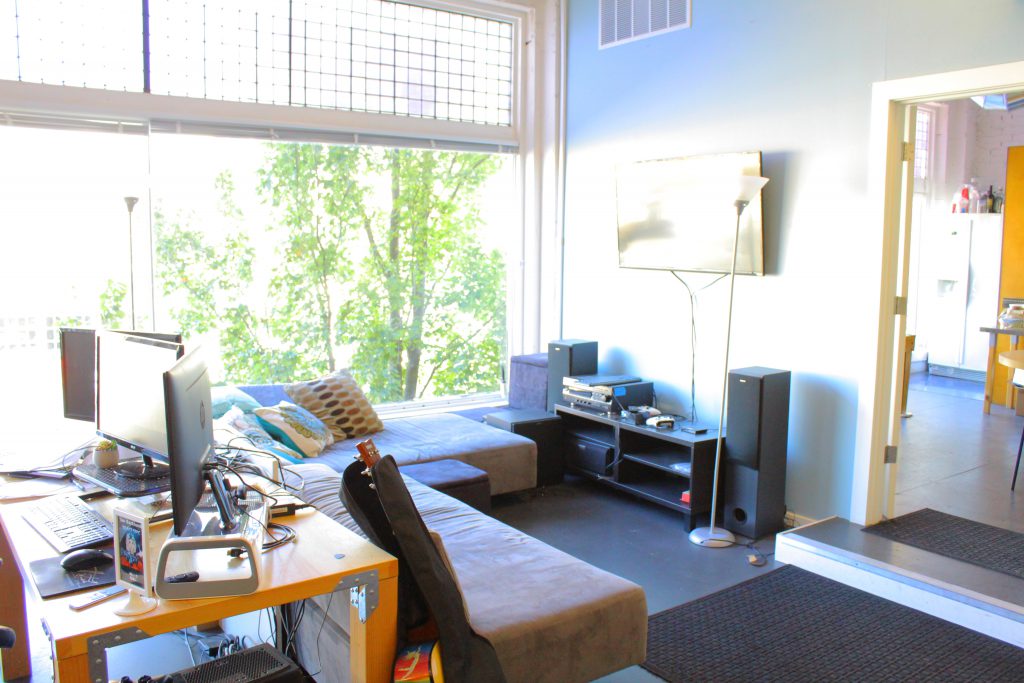
The communal area is the perfect place to take a chill and, surprisingly, play a game.
Ash: The people are just as much a benefit as the office. You’ve got minds, actual human resources who want to help support you along the way. How has the overall reception been to the game? When testers play for a while, how are they feeling?
Adrian: People who play through the whole demo generally love it, which is awesome. The response has been great. I don’t really have people telling me it’s terrible. Some people walk up, see that it’s a card game and walk away. It’s hard to say the general reception; it’s rare at a con for someone to walk up and tell you terrible things about your game. People tend to be nice. It’s different when I ship it and I have a review system.
Ash: There’s a removal when you’re not actually there in person.
Adrian: Oh yeah. Although sometimes you’ll hear people talking, and they don’t realize you’re the creator. I had a person complaining, not realizing that I’m the one who made it. They think it’s made by a company and I’m a representative, or a hired PR person. But nope, sorry, it’s me. But it’s been good! People love the cats, and understand the game mechanics. Which is great, because I wasn’t sure about that. It’s overall been pretty positive. We’ll see when I get the game out there.
Ash: One of the big things I heard a lot of at Pax Dev was having a simple idea that snowballed into something so much bigger, which increases cost, or help, or timelines. How do you reign that in? How do you stay away from feature creep, or the bigger, more exciting things in order to get your game out?
Adrian: That’s a good question, and I’m not sure I’m the person to answer that. I started with a small scope, with cats in a card game with a campaign mode. I started to see the potential, and the scope in my head blew up. I’ll have 20 cats, with 2 ability cards, and passive abilities. My suggestion is, if you have an idea and you want to execute it, what’s the fastest path to get to a playable state, where you can test if it’s fun. When I designed my game, I didn’t go through and develop all the ability cards of all the cats. I started with one, with Major Mittens. With one card with one ability, I saw how complex it will get. It’s not just one mechanic—you have the graphics, animations, complexities of both players having the card, etc. When I saw how complex it was with one, I reduced my scope to one ability per player. I started small and grew from that.
Ash: If you do it that way, you minimize your waste, too. If you start big and it doesn’t work, it’s more time and effort that got scrapped.
Adrian: When I worked on Windows, before Windows 7, they didn’t have a “gated build”. Vista was seen as a disaster because they tried to put every feature in every build, so you get half-baked features. 7 was a gated build, and I worked on the test team for that, and I learned from it. Taking that concept into my game, I’d rather have a fully functioning single ability than 3 broken features per cat. I can always add more, but I don’t have to finish if it I don’t have time.
Ash: Last question! We’ve talked a lot about the community. Seattle is just full of devs, indie and big. How has this dev community been for you, both in terms of cons and people you’ve worked with, and how has the fan community been in contrast?
Adrian: The indie game community here is awesome. I found my people. I’ve been a gamer since I was a kid, and I’ve played every day. Even at Xbox, not everyone played games. Going indie, you really get people who are truly in love with games. It’s hard to be indie and not like games. When you work big, you don’t have to actually play them. You have a salary, and if you succeed or fail, you get a check. Whereas indie, if you fail, that’s your livelihood, so you have that passion. With indie, these people really know the industry and love it. I play games, but I know people who play way more than me. That’s how I identify indie games here. It’s pretty friendly. Even at the social events, people are great. There’s an understanding as an indie where you can be really open with everything. If a fan came up and asked things like my budget for artists, I wouldn’t necessarily answer those. If an indie dev asked, I’d be more open to talking about that, because we’re in it together. Fans is a weird concept for me—I don’t know if I have a community yet, I’ve just shown twice. I have a mailing list, but I don’t have a fan community. But it’s exciting! We’ll see how it goes once I launch, and I start responding to emails and forum posts.
Ash: Last-last question, for real now! Something I also saw at Dev was a lot of the good attitude of being in it together, and sharing ideas and resources. Sometimes I still do see the “I won’t tell you because I want people to buy my game and not yours.” Have you encountered that, or is that pretty rare?
Adrian: It’s very rare. Working for a large company, that does happen, though. You get that animosity. Even at Microsoft, if you’re on one team and you want something from the other, it’s that “what can you do for me” attitude. But I don’t view other indie devs as competitors. Maybe more of a friendly competition? We’re all part of the same team even though we’re not. We want the same people playing our games, but we’re not AAA. I don’t feel like fellow indies view me that way either, at least in Seattle.
Ash: I’ve only really been exposed to the Seattle game devs, so it’d be interesting to see.
Adrian: Yeah, the Portland Indie Game Squad, the PIG squad, is really awesome too. And at cons, you’re booth buddies. You spend time together, and you’re both struggling to do the same thing, and to figure it out. At Geek Girl Con, I was next to Puzzle Depot, and I’d seen their game but I hadn’t played it. So I got a shot at it! And they posted on Twitter and tagged me, and I did the same. We try to help each other out.
Ash: That’s encouraging to hear. There’s so much animosity in certain areas of the game industry, so it’s great to know that the Seattle scene isn’t like that. So how close are you to shipping?
Adrian: I definitely want to ship this year. There’s more complexity to add, like multiplayer, or social aspects like leaderboards and achievements. I want the beta out this month, so 2 to 3 months of development work is my scope. I shouldn’t go above that. I’ve cut things here and there. So this year!
What’s next?
A huge thanks to Adrian for taking time to talk with me, and to the Indies Workshop for hosting our chat! You can sign up for the beta for Meow Wars now on their website, and keep an eye out for the review piece to get some more peeks into the absolutely fantastic cat combat!
I’m not sorry to warn you that there will be a lot of cat puns in that review. You love it.
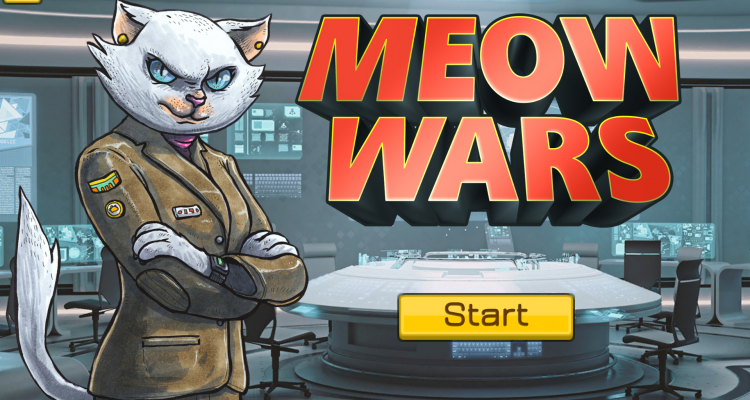

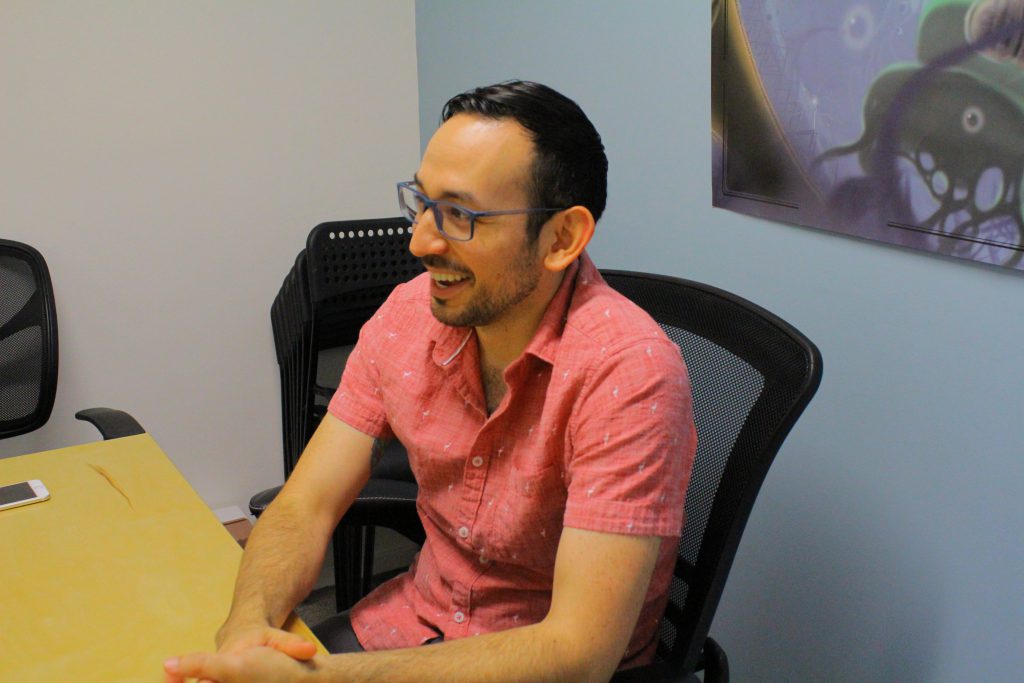

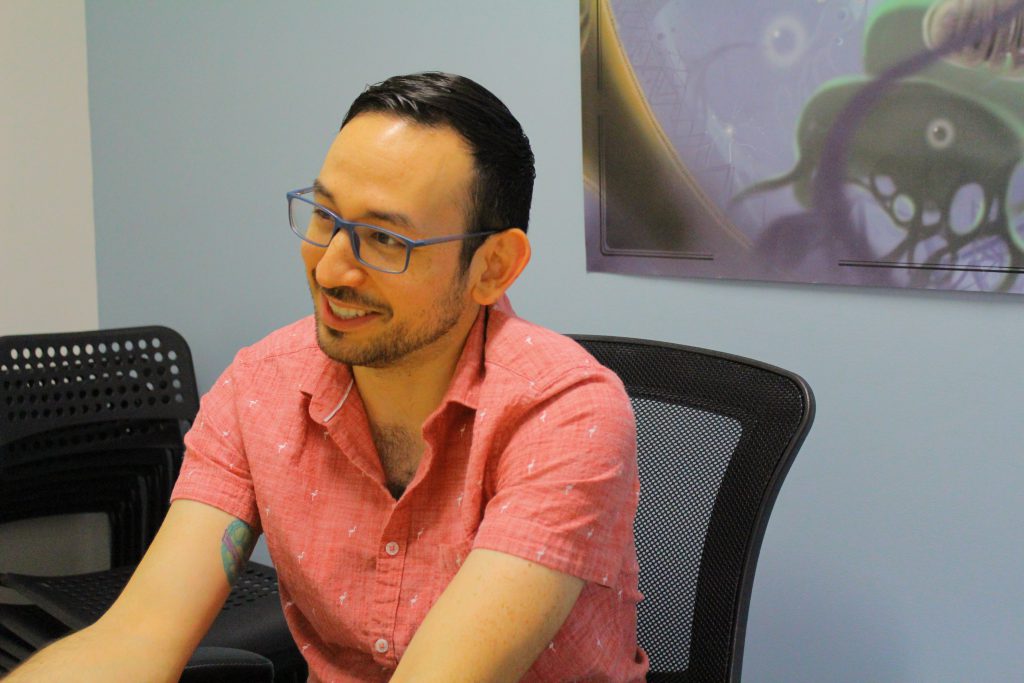
No Comments on "Where to start as an Indie Game developer: An interview with Meow Wars’ Adrian Sotomayor"